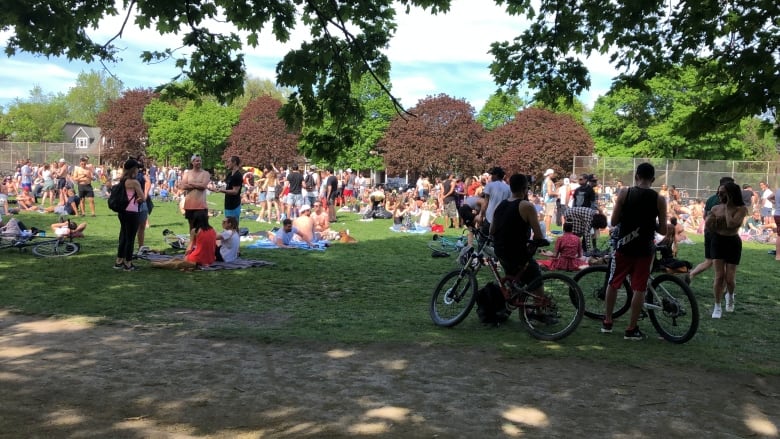COVID reopening: hoping it goes right - watching carefully how it might go wrong
With COVID-19 still circulating, how can we know if we need to lock down again?


Across Canada, lockdowns are easing and restrictions are lifting, despite COVID-19 still being a looming threat.
And while experts are all but certain that there will still be some future outbreaks of the disease, epidemiologists and public health officials across the country are keeping a watchful eye to make sure that these outbreaks don't get so large that further lockdowns are necessary.
"We know that physical distancing measures are challenging to maintain over the long term, and we know that this disease is transmitted by close contact, and so as those contacts start to creep up we will expect to see some amount of transmission beginning to happen," epidemiologist Dr. Amy Greer told Quirks & Quarks host Bob McDonald.
Greer, the Canada Research Chair in population disease modelling at the University of Guelph, is concerned that many provinces — like Ontario and Quebec — still have significant numbers of new cases, with limited testing and contact tracing, which is integral to minimize and contain any outbreaks of the disease.
"My worry is really that by the time we realize we are starting to have a growing problem again, as indicated by things like ICU admissions and deaths, we will have so much underlying transmission in the community that it will be very challenging to control at that point," said Greer.

Most ways of keeping tabs on the disease are what Greer calls "lagging indicators," meaning, they represent transmission events from days or even weeks earlier. However, one way that officials are keeping track of the disease is by watching a metric called the reproductive number. That represents the expected number of new cases of COVID-19 caused by each individual case.
"Our goal is to try to drive that number below 1. And that tells us that we're slowing epidemic growth. And so that effective reproductive number is something that we really keep a close eye on on a daily basis," said Greer.
Getting the public to follow the rules is easier said than done
One of the key components in keeping the novel coronavirus under control is public compliance with physical distancing rules, and following suggestions such as to wear a mask in crowded areas, and avoiding large groups.
However, after nearly 11 weeks of lockdowns, the public's desire to follow the rules could be waning, something that behavioural scientists are not surprised by. "From a behavioural scientist point of view, this is a festival of cognitive and behavioural tendencies that is going on with individuals," said behavioural economist Dr. Nicola Lacetera.
Lacetera studies what motivates human altruism. He's also recently studied psychological factors that go into whether or not people comply with lockdown orders, and he's now looking at how willing people may be to partake in the reopening economy, given that the COVID-19 threat is still lurking in the background.
"One issue I see with the reopening is how different people might draw their line, and to what extent they will be able to to coordinate in drawing the appropriate line for different activities," he said.
As restrictions start to lift and people begin to decide which rules to follow and which precautions to take, Lacetera warns that the danger is that too many people decide to draw that line too far.
"Some people start being too overconfident, thinking that, someone else will be infected, I'm fine I'm strong, I'm healthy, so I can go out. But of course if everybody starts thinking that way, everybody goes out. And of course then we have a problem," he said.

However, on the flipside, if too many people decide to stay in strict lockdown, that doesn't help, either.
"From an economic point of view — because this is also what the reopening is about, revitalising the economy — if people are too scared, more than they should be in a sense, then people are not going to go out. And so you can also have this opposite effect," he said.
Manage expectations, and make rule-following the social norm
Lacetera points to media reports showing people flouting the rules, such as last weekend's gatherings at Toronto's Trinity Bellwoods Park, as potential evidence of lockdown fatigue. If following the rules is promoted as a social norm, more people will be able to bear that burden.
He also says that consistent messaging from leaders in charge is key.
"So for example the idea of promising only two more weeks, and then two more weeks, or moving the goalposts continuously, might really upset individuals and create a negative attitude toward these activities," he said.
"Expectations play a big role because at the end of the day, in a democratic society you cannot impose distancing or full blown isolation by putting the police or the military everywhere. We have to rely on individual willpower."
Produced by Sonya Buyting. Written by Amanda Buckiewicz.